Dive Details
Location
Logged dive number
1728
Date
Saturday 30 November 2019
Time
9:43am - 11:58am
Buddy
Mike Scotland
Seas
Strong current and some surge
Visibility
5 to 15 metres
Duration
135 minutes
Surface interval
Maximum depth
21.4 m
Average depth
14.1 m
Water temperature
16.9°C
Dive Profile from Citizen Hyper Aqualand

Tides at Botany Bay AEDT
Note that tides at dive site may vary from above location.
Low
5:05am
0.57m
High
11:39am
1.79m
Low
6:29pm
0.37m
Details
Mike joined me for today's dive at The Leap. Nicolas and Lena went in around 30 minutes before us on their rebreathers and they were going to go slowly and then join us when we caught up. The forecast for swell was a north-easterly of 1-2 metres and a southerly of around a metre but the winds were going to be up to 30 knots. When we checked out the entry it looked like the wind was having a lot of impact on the surface.
When we went to get in there was way too much water movement over the low shelf so we slid down the wall. We swam out on the surface and the current was already taking us towards The Steps. We descended and I tried to head at between 50 and 60° towards the sand line. The current was very strong and I ended up at the sand line between Ian's Pygmy Rock and Seahorse Rock. I suspected I was now ahead of Nicolas and Lena. Mike was somewhere ahead of me. The current was very strong. The visibility was 10 to 15 metres and the water temperature was around 18°C. There was only gentle surge but probably because the current was overpowering it.
I drifted with the current to Seahorse Rock and then looked on one of the rocks behind it for the red male pygmy pipehorse I'd found 6 weeks ago. He (IL2019102001) was very easy to spot. He was not so easy to photograph because of the strong current. I looked around for the female but was not able to find her.
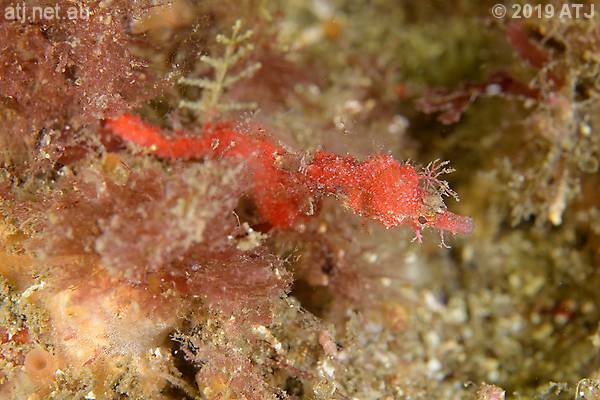
Male Sydney Pygmy Pipehorse, Idiotropiscis lumnitzeri, (IL2019102001). 20.6m.
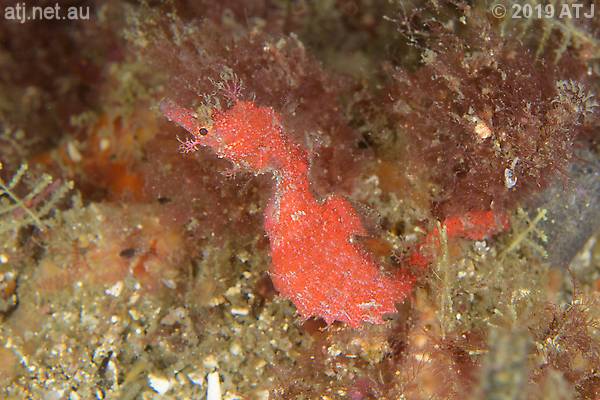
Male Sydney Pygmy Pipehorse, Idiotropiscis lumnitzeri, (IL2019102001). 20.4m.
I continued on towards the overhang, mostly drifting with the current rather than swimming. The water temperature dropped to around 17°C. I spotted "Clyde", the male Weedy Seadragon, under the overhang. He still had some eggs although they were old and he'd lost many of them.

Weedy seadragon, Phyllopteryx taeniolatus, ("Clyde"). 20.6m.

Weedy seadragon, Phyllopteryx taeniolatus, ("Clyde"). 20.7m.
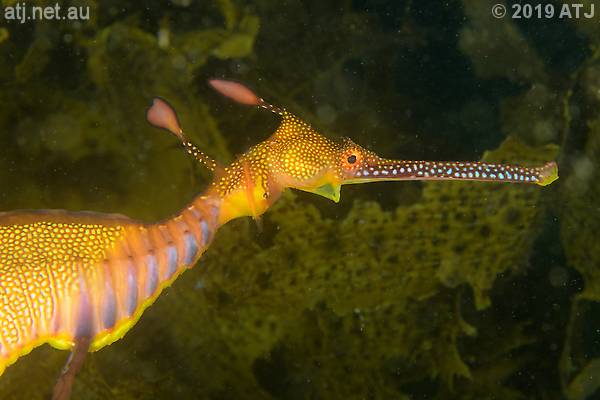
Weedy seadragon, Phyllopteryx taeniolatus, ("Clyde"). 20.7m.
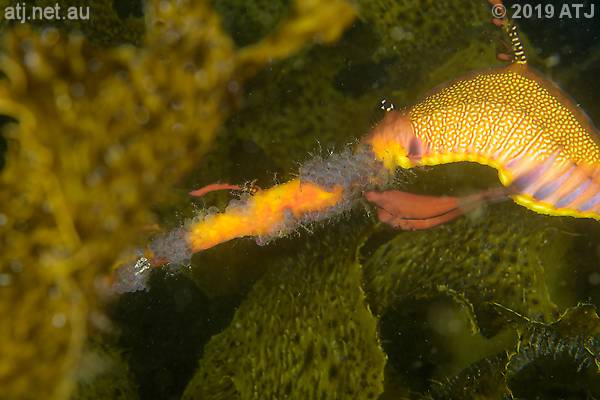
Eggs on the tail of a male Weedy seadragon, Phyllopteryx taeniolatus, ("Clyde"). 20.6m.
I swam to the next gap and caught up to Mike. He pointed out the large juvenile Weedy Seadragon. I took some photographs of it.
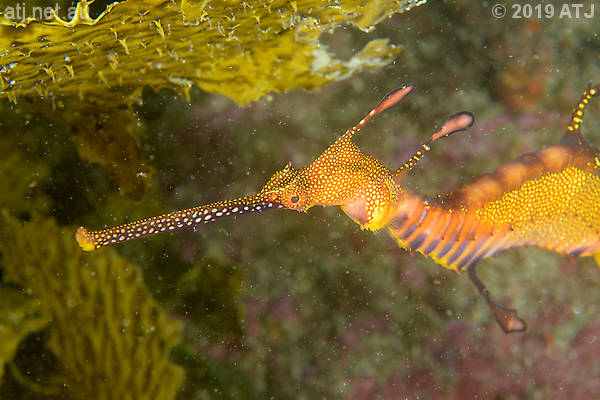
Weedy Seadragon, Phyllopteryx taeniolatus. 20.1m.
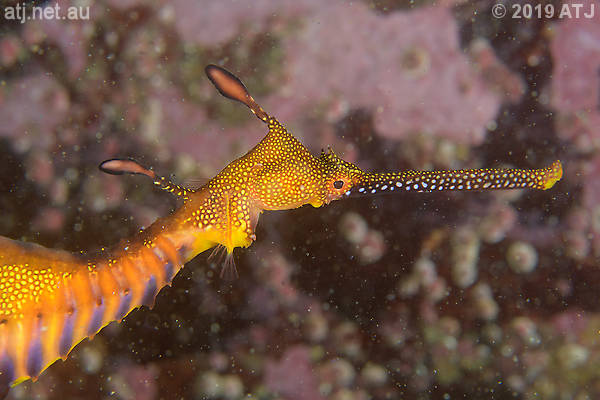
Weedy Seadragon, Phyllopteryx taeniolatus. 19.8m.
I then looked around the area for the female weedy that has been around. I found her over by the sand line. As I was taking photographs of her she headed back towards the other two. Mike had gone on ahead so I couldn't show her to him.

Weedy Seadragon, Phyllopteryx taeniolatus. 19.7m.

Weedy Seadragon, Phyllopteryx taeniolatus. 19m.
I headed towards Southern Cross Rock. I looked on the rock below Bent Stick Rock and spotted a Reaper Cuttlefish. A little farther along I spotted an Eastern Smooth Boxfish.
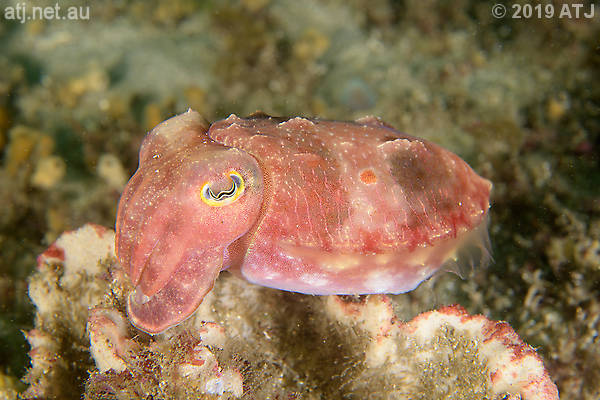
Reaper Cuttlefish, Sepia mestus. 19.8m.
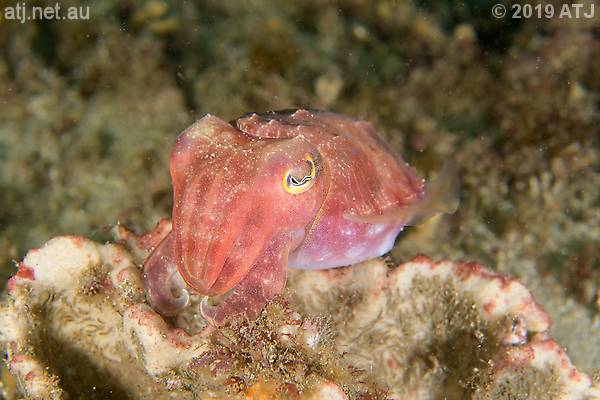
Reaper Cuttlefish, Sepia mestus. 19.6m.

Eastern Smooth Boxfish, Anoplocapros inermis. 20m.
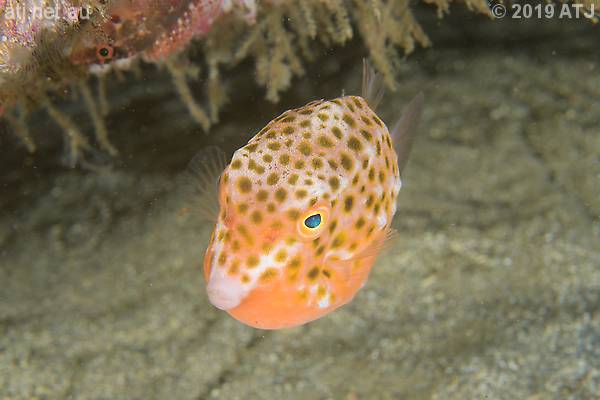
Eastern Smooth Boxfish, Anoplocapros inermis. 19.9m.
I stopped at Southern Cross Rock and looked on the side for pygmy pipehorses. I didn't find any.
I continued on the current into Seadragon Alley. I was hoping to find some weedies, especially the large juvenile but found none. I caught up to Mike towards the end of Seadragon Alley.
As we headed to Big Rock, I checked the red algae for red pipefish. It is now over a year since I last saw any of these pipefish.
Just after Big Rock I looked in the finger sponges for "Ouz", the yellow White's Seahorse. I've seen her quite a few times there but not every time I've looked. I wonder where she goes on the times I can't find her.
We continued to Long Rock. I looked for the pygmy pipehorses there. I first spotted the female (IL2019102702) and after a bit of searching I found the male (IL2019112401). I called Mike down and pointed them out to him.

Female Sydney Pygmy Pipehorse, Idiotropiscis lumnitzeri, (IL2019102702). 14.3m.
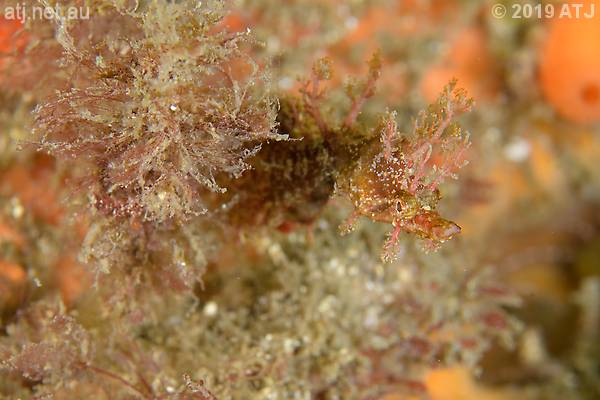
Male Sydney Pygmy Pipehorse, Idiotropiscis lumnitzeri, (IL2019112401). 14.5m.
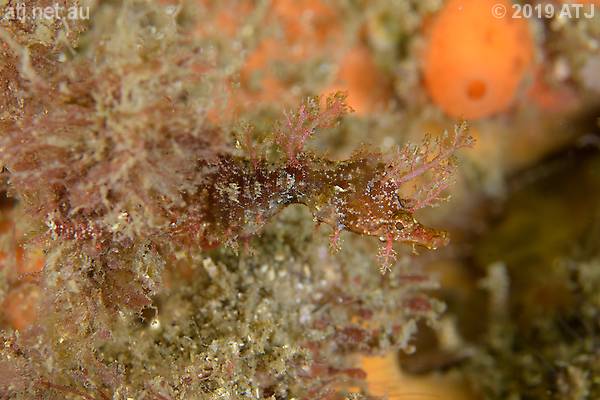
Male Sydney Pygmy Pipehorse, Idiotropiscis lumnitzeri, (IL2019112401). 14.6m.
I swam to the Doughboy Scallop and then up to the orange Red-fingered Anglerfish. It was still in the same hole it had been two weeks ago when Mike first pointed it out to me. (What I didn't realise until I looked at my photographs at home was that it had eggs!)
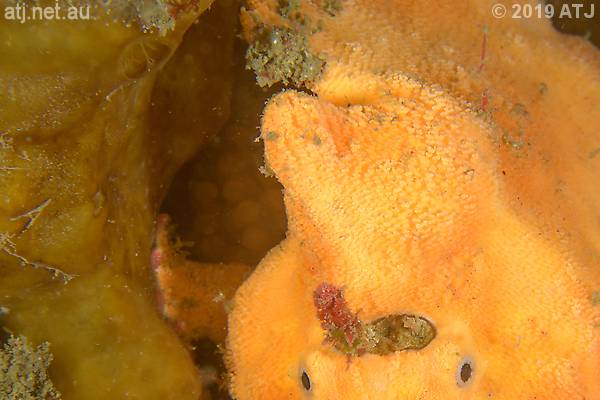
Red-fingered Anglerfish, Porophryne erythrodactylus. Note the eggs behind his right side. 12.8m.
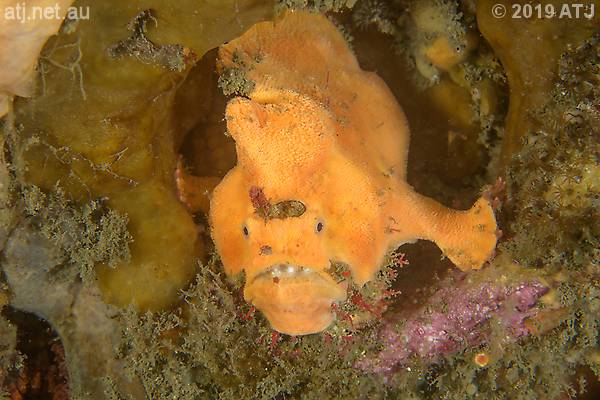
Red-fingered Anglerfish, Porophryne erythrodactylus. Note the eggs behind his right side. 12.8m.
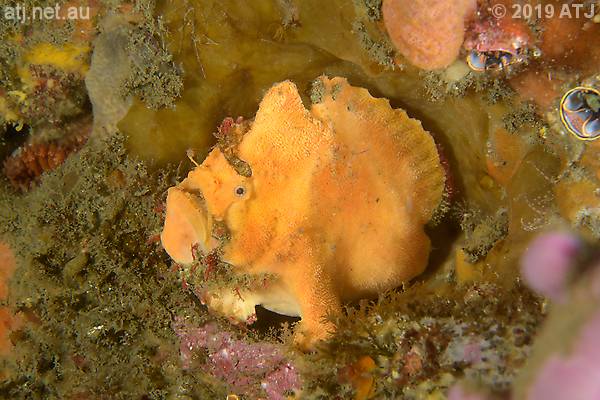
Red-fingered Anglerfish, Porophryne erythrodactylus. 12.8m.
On my way to the next pair of pygmy pipehorses I spotted a tube-building amphipod. I see these quite frequently now.
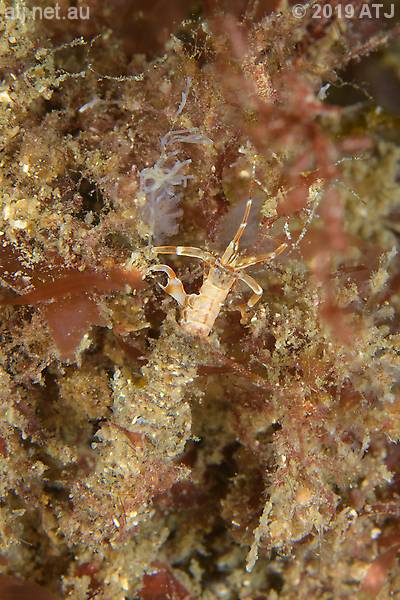
Tube-building amphipod, Kapalana wadei. 13.8m.

Tube-building amphipod, Kapalana wadei. 13.9m.
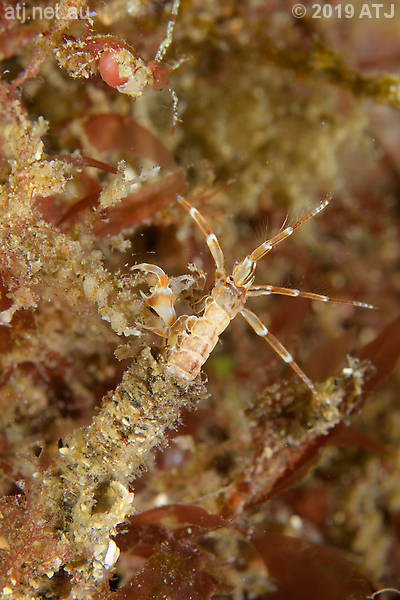
Tube-building amphipod, Kapalana wadei. 13.8m.
At the next pair of pygmy pipehorses I found the female (IL2019100503) quite quickly. While I was looking for the male, Mike called me up to Sponge Hollow. He'd found a Miamira magnifica nudibranch. It was larger than the other one that has been around a few months.

Female Sydney Pygmy Pipehorse, Idiotropiscis lumnitzeri, (IL2019100503). 13.9m.
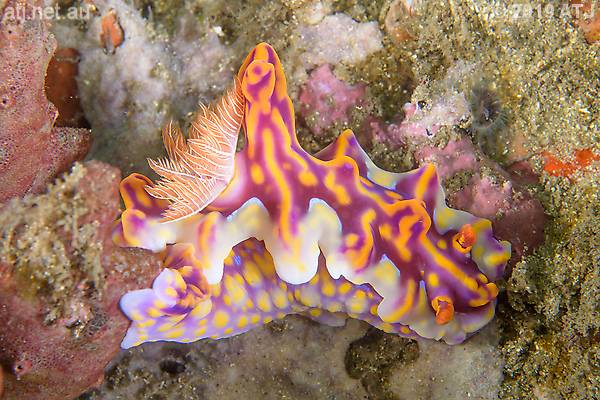
Nudibranch, Miamira magnifica. 13.4m.
We headed back to the pygmy pipehorses. I found the male (IL2019100601) on the top of the rock. I pointed both out to Mike. Mike then left me as he was getting low on air. I still had plenty. (I was had my 7L pony and with the current we hadn't spent long at depth.)
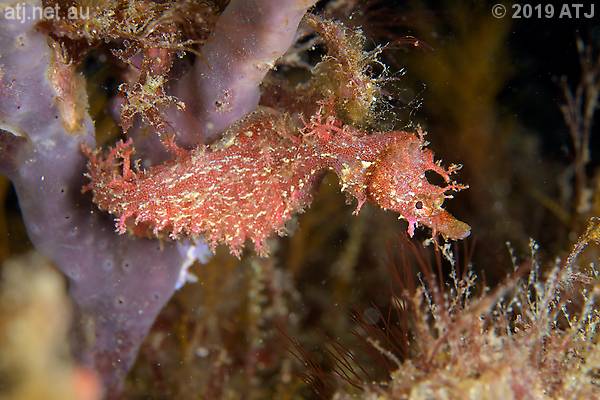
Male Sydney Pygmy Pipehorse, Idiotropiscis lumnitzeri, (IL2019100601). 13.5m.

Male Sydney Pygmy Pipehorse, Idiotropiscis lumnitzeri, (IL2019100601). 13.6m.

Female Sydney Pygmy Pipehorse, Idiotropiscis lumnitzeri, (IL2019100503). 13.9m.
I continued to the rock where I had found the red male pygmy pipehorse a few weeks ago. I hadn't seen it last Sunday but I was hoping to find it again today. I didn't.
I followed the reef to Diversity Rock. I spotted the smaller Miamira magnifica nudibranch straight away in the same spot it has been for weeks.

Nudibranch, Miamira magnifica. 14m.
I swam up to the basket star, looking for Red-fingered Anglerfish on the way. I then headed towards Little Big Rock to the black Painted Anglerfish. It was in the same spot where Dom had pointed it out last Sunday.
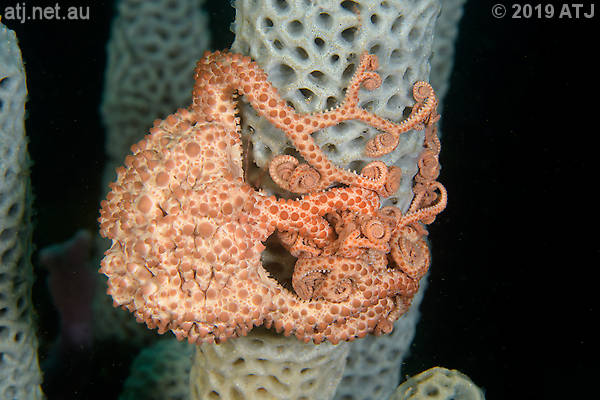
Basket star, Astrosierra amblyconus. 12.4m.
I still had plenty of air so I headed back along the top of the reef to New Basket Star Rock and the farther rock looking for more anglerfishes and also red pipefish. There is barely any red algae in that area now.
I came back via the smaller Miamira magnifica and the black Painted Anglerfish.

Painted Anglerfish, Antennarius pictus. 12.6m.
I swam on to the seahorses behind Little Big Rock. I found "George" low down on the rock and "David" on the side of the rock in the sea tulips. I looked all around the rock for "Skye" but could not find her.
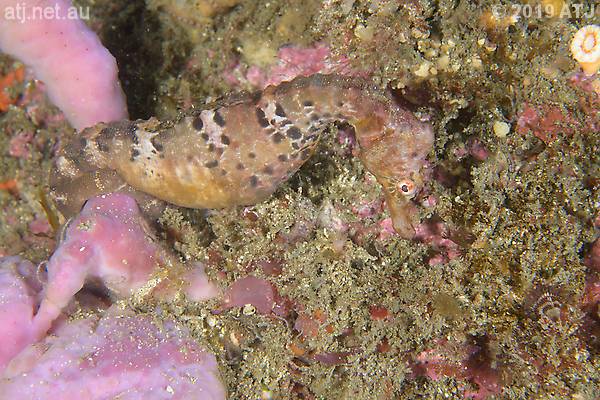
Male Pot-bellied Seahorse, Hippocampus abdominalis, ("David"). 12.4m.
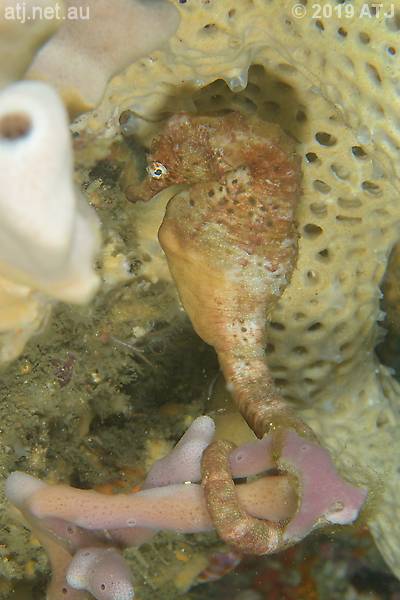
Male Pot-bellied Seahorse, Hippocampus abdominalis, ("George"). 12.4m.
I headed along the top of the reef for a short way before heading down to the sand line near the rock where the large yellow Red-fingered Anglerfish had spent a lot of time. I looked for anglerfishes but found none.
I followed the sand line towards Pipefishes Hole. I spotted a large school of Painted Catfish out on the sand just before the kelp on the Little Big Rock side of Pipefishes Hole. I took some photographs of them.
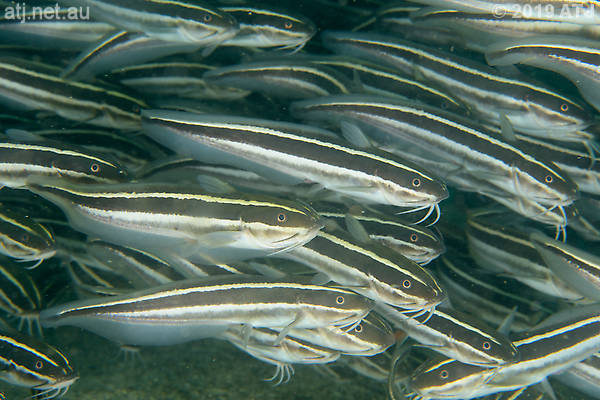
Striped Catfish, Plotosus lineatus. 13.7m.
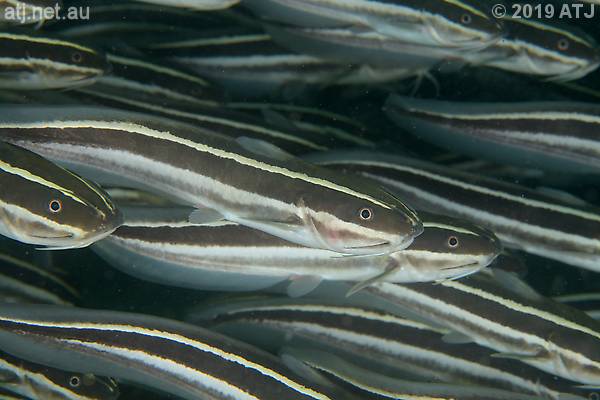
Striped Catfish, Plotosus lineatus. 13.6m.
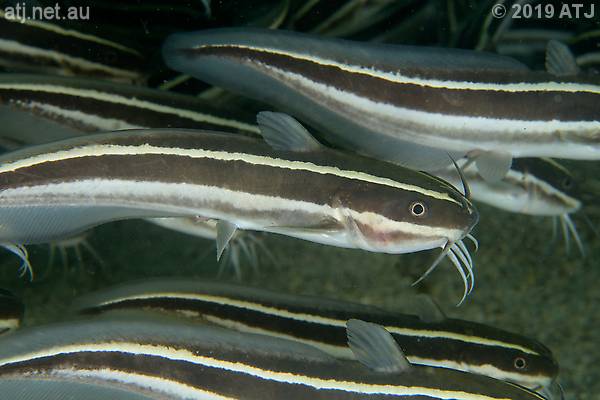
Striped Catfish, Plotosus lineatus. 13.7m.
On the other side of the kelp, just before Pipefishes Hole, I spotted "Teardrop", the male Weedy Seadragon. His eggs are progressing well. I was taking photographs of him and then I noticed a huge amount of sand in the water around me. I knew I wasn't stirring it up. I looked up to see a group of newbie divers kicking the shit out of the sand. The created a sand storm that was 20 metres across. I gave up and swam up to Di's Rock just out of the storm and to give it a few minutes to settle.
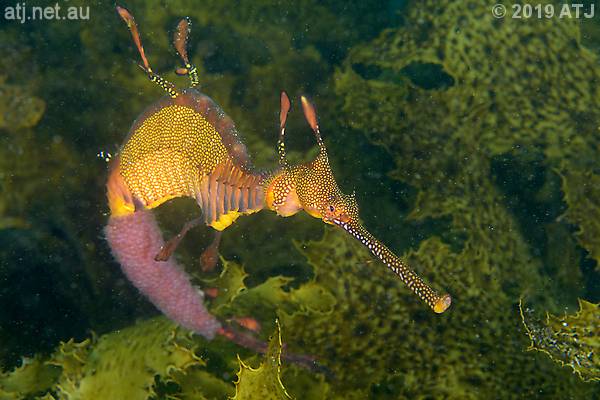
Weedy seadragon, Phyllopteryx taeniolatus, ("Teardrop"). 13.4m.
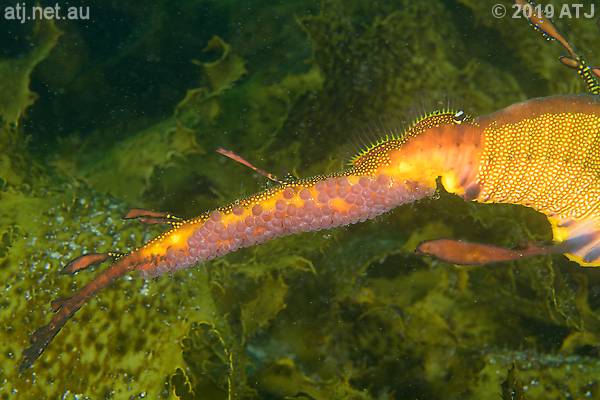
Eggs on the tail of a male Weedy seadragon, Phyllopteryx taeniolatus, ("Teardrop"). 13.6m.
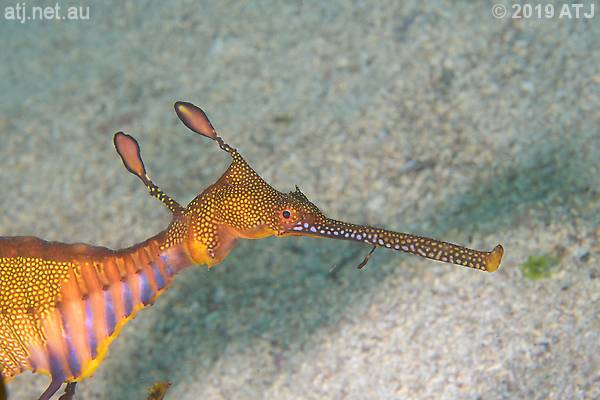
Weedy seadragon, Phyllopteryx taeniolatus, ("Teardrop"). 13.4m.
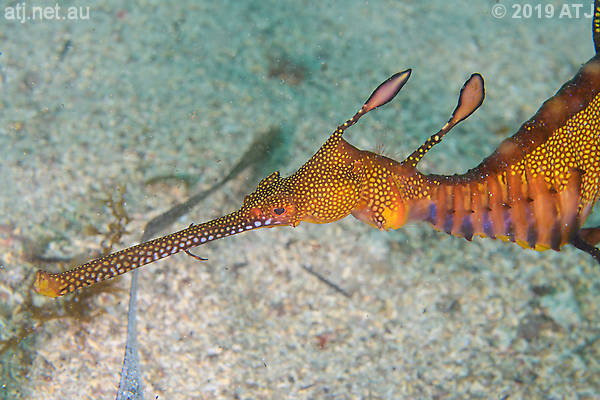
Weedy seadragon, Phyllopteryx taeniolatus, ("Teardrop"). 13.4m.
I came back down to Pipefishes Hole and much of the sand had settled. I looked in the hole and spotted one of the Upside-down Pipefish and took some photographs. I tried to get some more photographs of "Teardrop" but there was still too much sand in the water.
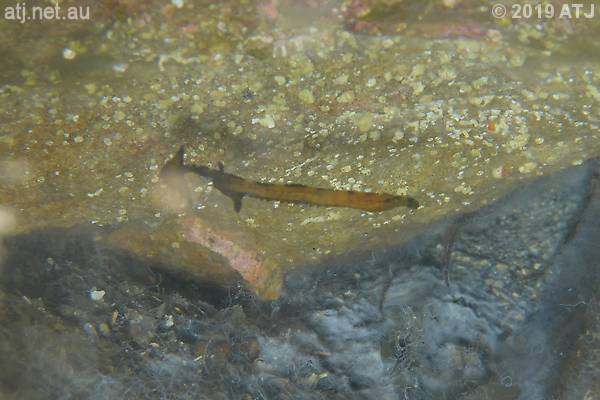
Upside-down Pipefish, Heraldia nocturna. 13.7m.
I followed the sand line to the last large rock on the sand line before the exit. This was the rock where the Pot-bellied seahorses had been last year. Mike had told me about an orange Red-fingered Anglerfish he'd found there in the last week. I looked for it and spotted it near the top of the rock.
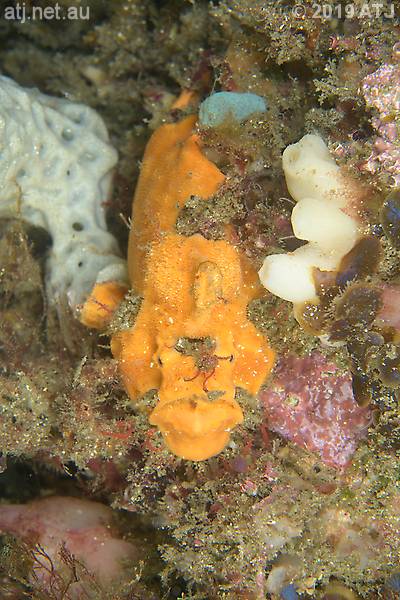
Red-fingered Anglerfish, Porophryne erythrodactylus. 11.5m.
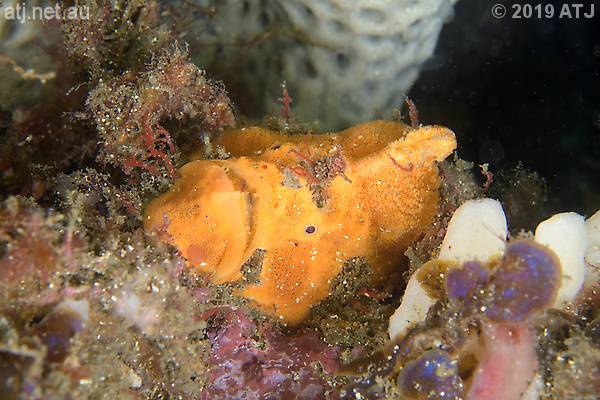
Red-fingered Anglerfish, Porophryne erythrodactylus. 11.4m.
I continued through the kelp to the rocks in front of the entry/exit. I looked for anglerfishes but found none.
I ascended to Split Rock and started my safety stop. When my 5 minutes were up, I swam underwater to the exit where I got out. The tide was still quite high and the exit was easy.
Camera gear
Camera
Nikon D500
Lens
Nikon AF-S Micro Nikkor 60mm f/2.8G ED
Housing
Ikelite 6812.5
Lens port
Ikelite Flat Port 5502.41
Strobe(s)
2 x Ikelite SubStrobe DS161